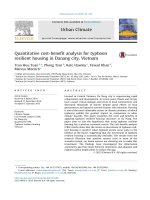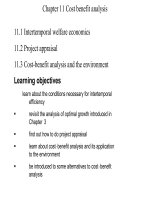Applied welfare econ cost benefit analysis ch3
Bạn đang xem bản rút gọn của tài liệu. Xem và tải ngay bản đầy đủ của tài liệu tại đây (573.04 KB, 28 trang )
Applied Welfare Econ & Cost Benefit Analysis
Chapter 3
Basics of Cost Benefit Analysis
DEMAND CURVES
downward slope, which is due to diminishing
marginal utility,
they indicate willingness to pay (WTP) for various
quantities of the good
Consumer surplus can be derived from a demand
curve. The area under the market demand curve
(i.e., the horizontal sum of the individual demand
curves) is society's WTP for good X (see Figure 3.1)
This area, WTP, is defined as the gross benefits of
society for consuming X* amount of the good.
DEMAND CURVES
If one has to pay P* for X* amount of the good,
then the rectangle bounded by P* and X* is the
aggregate cost.
The net benefits, therefore, are the gross benefits
minus the costs (the area between the demand
curve and the P* line). The net benefits are called
the consumer surplus (CS).
The reason consumer surplus is important to CBA
is that changes in CS can be viewed as close
approximations of the WTP for (or benefits of) a
policy change.
DEMAND CURVES
This is an inverse demand curve
DEMAND CURVES
Changes in Consumer Surplus
If the price increases (decreases), less (more) of a good is
demanded and the CS changes [see Figures 3.2 (a) and
3.2(b)].
If the change in price and quantity are known and the
demand curve is linear, Equation 3.1 can be used to solve
for changes in CS.
If the change in quantity is not known, the price elasticity of
demand may be used to approximate it (see Equation 3.3).
If the price change is due to a tax, the lightly shaded
rectangle in Figure 3.2 is a transfer and the dark1y-shaded
triangle is the deadweight loss.
SUPPLY CURVES
The upward sloping segment of a firm’s marginal cost
curve above its average variable cost curve is the
supply curve (below the average variable cost, the firm
would shut down)
The marginal cost curve is the additional opportunity
cost to produce each additional unit of the good
The area under the curve represents the total variable
cost of producing a given amount of the good
SUPPLY CURVES
The upward sloping segment of a firm’s marginal cost curve
above its average variable cost curve is the supply curve
(below the average variable cost, the firm would shut down)
What does the supply curve of a monopolistically
competitive firm look like?
SUPPLY CURVES
The variable costs that are of concern in CBA are
opportunity costs (i.e., the value of goods and services that
the resources could have produced in their next best use)
What is counted as variable costs should be appropriate to
the policy in question and could cover the short run (labour
varies and capital is fixed) or the long run (all inputs vary)
The market supply curve (similarly to the market demand
curve) is the horizontal sum of all individual supply curves.
Producer surplus is the difference between total revenues (a
rectangle bounded by P* and X* in Figure 3.4) and the
supply curve.
SUPPLY CURVES
SUPPLY CURVES
SOCIAL SURPLUS AND
ALLOCATIVE EFFICIENCY
Consumer surplus plus the producer surplus equals social
surplus
Social surplus is the area between the demand and supply
curves to the left of the equilibrium point
In perfect competition, the equilibrium output X* (where
the supply and demand curves intersect) maximizes the
social surplus.
SOCIAL SURPLUS AND
ALLOCATIVE EFFICIENCY
SOCIAL SURPLUS AND
ALLOCATIVE EFFICIENCY
Example of distortion from equilibrium:
The government sets a "target" price (PT) for a good above its
equilibrium price.
Sellers now desire to sell more of the good (XT) at price PT, but buyers
are only willing to pay PD for that amount (see Figure 3.6).
The government makes up for the difference between PT and PD with a
subsidy (area PTdePD).
This causes consumer surplus (area aePD) for buyers and producer
surplus (area PTdc) for sellers to increase, while taxpayers pay for
those surpluses (a transfer) and suffer a deadweight loss (area bde).
The proportion of every dollar given up by one group, but not
transferred to another group (i.e., the deadweight loss), is called
leakage.
SOCIAL SURPLUS AND
ALLOCATIVE EFFICIENCY
APPENDIX 3A: CONSUMER SURPLUS
AND WILLINGNESS TO PAY
When does consumer surplus provide a close
approximation to WTP and when it does not?
Compensating Variation:
the amount of money a consumer is willing to pay to avoid
a price increase is the amount required to return the
consumer to the same level of utility prior to the price
change.
APPENDIX 3A: CONSUMER SURPLUS
AND WILLINGNESS TO PAY
Hyperquick review of indifference maps (Figure
3A.1):
All points on an indifference curve represent the
same level of utility.
The straight line connecting the Y and X axes is
the budget constraint.
Budget constraints further away from the origin
indicate higher income.
Indifference curves further away from the origin
indicate higher utility.
APPENDIX 3A: CONSUMER SURPLUS
AND WILLINGNESS TO PAY
Hyperquick review of indifference maps (see Figure 3A.1):
The slope of a budget constraint depends upon the price of
X relative to the price of Y.
Indifference curves are negatively sloped because an
increase in consumption of one good must result in a
reduction in the consumption of the other good for utility
to remain unchanged.
Indifference curves are convex due to diminishing
marginal utility (i.e., the more of good X one has, the less
one is willing to give up some of good Y for more of good
X).
APPENDIX 3A:
Figure 3A.1 illustrates the effects of a price change on an
individual.
Initially, the individual is on indifference curve U1 and
consumes Xa.
If the price of X increases, the budget constraint line
becomes steeper and the individual falls to a lower
indifference curve (U0) and consumes less of good X (Xb).
If he is paid a lump sum of money to compensate him for
the price change, the budget constraint shifts to the right
(parallel to the prior one), and the individual returns to the
original indifference curve (U1) and now consumes
amount Xc of good X.
APPENDIX 3A:
Figure 3A.1 illustrates the effects of a price change on an
individual.
The change in demand from Xa to Xc is the compensated
substitution effect -- the change in demand for X due to a
price change in X when the individual is compensated for
any loss of utility (i.e., stays on same indifference curve).
This effect always causes demand for a good to change in
the opposite direction from the change in the price.
The change in demand from Xc to Xb is the income effect
(the increase in the price of X reduces the individual's
disposable income). For normal goods, this also causes
demand for the good to change in the opposite direction
from the change in the price.
Demand Curves again
Knowing the information above (i.e., the old and new prices of X and
the amount of X the consumer demands at those prices -- both with
and without his utility held constant) from an indifference curve
allows us to determine two points on two different demand curves.
If it is assumed that the curves are linear, then one can determine
both curves.
The first, a Marshallian demand curve, incorporates both the
substitution and income effects (while holding income, price of other
goods, and other factors constant).
The second, a Hicksian demand curve, holds utility constant and,
therefore, incorporates only the substitution effect.
Due to the difficulty of holding utility constant, Hicksian demand
curves cannot usually be directly estimated (although they can
sometimes be inferred).
Equivalence Of Consumer Surplus And
Compensating Variation
For CBA purposes it is important to measure
compensating variation because it provides an
approximation of WTP
Equivalence Of Consumer Surplus And
Compensating Variation
Measuring it can be done in two ways:
First, it can be measured on an indifference curve
diagram as the vertical difference between the
new budget constraint due to the price change
and the parallel constraint after making the lumpsum payment that returns the individual to the
original indifference curve.
Equivalence Of Consumer Surplus And
Compensating Variation
Measuring it can be done in two ways:
The second way to measure it is as the change in consumer surplus
on a Hicksian compensated variation demand curve.
The Marshallian demand curve, however, is sometimes the only one
that is usually available.
Computing consumer surplus on a Marshallian demand curve will be
different than a Hicksian compensated variation demand curve
because the income effect will be inappropriately included (if price
increases, CS is smaller on a Marshallian than on a Hicksian demand
curve; and if price decreases, it is larger).
The difference is usually small, however, and can be ignored unless
large prices changes in key goods (housing, leisure, etc.) are being
considered.









